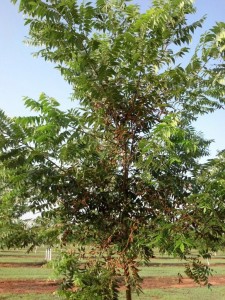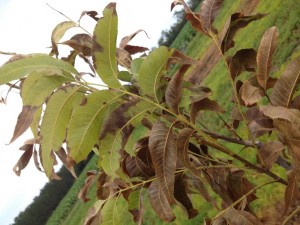For the last few years, I have had many calls related to the leaves of young pecan trees scorching and often dropping from the tree in mid-summer. We’ve investigated this from a number of angles and while a host of factors can contribute to the problem (nutritional imbalance, cold damage, etc.), it appears to me that what we are seeing is primarily an environmentally related problem affecting tree establishment. Many times when the leaves of a tree scorch in mid-summer, its an indication that there is a problem with the root system or vascular system of the plant.
When trees are transplanted in to the orchard from the nursery they will inevitably go through a period of “transplant shock”. If everything is done correctly and growing conditions are suitable, the trees recover from this within the first month or two following budbreak as the roots grow and the tree gets its root foundation established. At this point, the tree begins developing vigorous shoot growth if all is well.
I’ve talked and written a lot about the need for irrigation on young pecan trees. But, there is a love/hate relationship with pecan trees and water. Soil moisture is the key to making young pecan trees grow but this must be in combination with well-drained soil. Pecan trees like water but they don’t like to be water-logged. This is why they do not survive well when planted in low-lying, poorly drained soils. The tree’s roots can’t receive enough oxygen and they essentially drown, causing the roots to die-back. Even in a well drained soil, after periods of heavy rainfall when the soil may stay wet for an extended period, you can get a little root die-back. As the soil dries out, new roots grow and replace those that were lost. This is a normal process and is usually not a big deal for a tree that is already established. The root system is large enough to compensate for the losses.
But, for a tree still trying to get its roots established, this situation can cause problems because the root system is already very limited. In my research, I do a lot of measurement of tree water stress. First year trees are usually much more water-stressed than more established trees, even under the best management as a result of their limited root system.
The nutritional status of the trees coming out of the nurseries is usually excellent and this is what most trees’ growth feeds off of for their first year following transplant (even though many growers apply a lot of fertilizer in the first year). As a result, these young trees often attempt to push out with vigorous shoots. The harder a young tree is pushed for growth with nitrogen, the greater potential for problems in this situation. When the limited root system cannot keep up with the growth that tree is trying to make, issues can arise.
For the last three years, we have had some pretty wet weather in the spring, as the graph below indicates. 2012 was an exceptionally dry spring with about a 2″ deficit in rainfall for April. However, from 2013-2015, we have had April rainfall amounts from 1″ to over 5″ above the average. In addition, 2013 remained wet season-long.
Following April, the weather conditions got hot and dry in 2014 and 2015. When the limited root system of young trees gets water-logged and many of the remaining roots suffer or die from lack of oxygen, the tree must re-grow these roots to support the growth of foliage. As the weather turns hot and dry immediately following such a period of heavy rainfall, the tree does not have enough time to develop a new root system adequate to meet the increased water demand under these conditions. When this occurs, the tree responds by shutting down and sacrificing some of its foliage in order for the tree to have the resources it needs to survive. This leads to the scorching and in some cases, dropping of leaves.
While nutritional problems like N:P or N:K imbalance can also lead to scorching, most of the time when we have compared leaf tissue analysis of these scorched trees with healthy trees from the same orchard, there is no difference. I have compared water stress on scorched vs. healthy trees as well, and in most cases the scorched trees are extremely water stressed compared to healthy trees, even though they are under adequate irrigation. In such a case, the root system is simply not capable of transporting that water to the tree as it needs to because the root system is still too limited.
Cold injury that damages the tree’s vascular system causes a similar response (and we have certainly had some of that as well over the last few years). But, if cold damage is not apparent, it is likely, the problem is simply that the tree has not yet established enough of a root system to support its growth. The problem may be more likely to show up on sandy or heavy clay soils or those with poor fertility, such as that found on sites planted in pine trees immediately prior to pecan planting.
The good news is that these trees will usually grow out of this scorching problem as more suitable growing conditions arise. It may take them 4 or 5 years to reach that point but they do seem to grow out of it with no long term damage.



